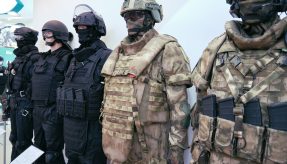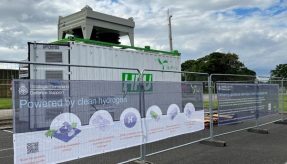
Atkins’ Elspeth McIntyre considers how asset data can help defence to meet its decarbonisation targets.
Across the globe, nations’ national defence organisations are major asset owners and – consequently – major contributors to greenhouse gas emissions. The UK’s Ministry of Defence, for example, owns about 1% of the UK’s total landmass, worth £40.8 billion, and equipment assets of £44 billion[1]; while Canada’s Department of Defence owns 2.2 million hectares of land and built assets worth CAN$28 billion[2]. Both organisations, although committed to achieving net zero emissions by 2050, began their decarbonisation journeys from a level where they were responsible for around half of their respective governments’ carbon dioxide emissions.

Elspeth McIntyre
With asset ownership on such a large scale, the challenge of emissions reduction for these defence organisations is similarly vast. From buildings, to vehicles, to airfields, each asset’s carbon footprint must be baselined and understood before reduction targets can be set and action taken. But it is not just defence organisations themselves that must contribute to decarbonisation; suppliers have a key role to play in understanding carbon emissions across the whole asset lifecycle, from design to disposal. For both owners and suppliers, an appropriate data architecture will be critical in achieving this goal.
Data architecture to deliver decarbonisation
Data architectures – which describe how an organisation’s data is collected, stored, processed, changed and shared – are driven by and facilitate strategic goals. They set in place a structure, supported by policies, models and standards, that manages the flow of data to where it is needed by users. Good data architectures enable sharing and integration across borders and between departments, as well as the improvement of data quality, and avoid ‘siloes’ of information and duplication of storage. Having an appropriate data architecture in place will enable defence organisations to undertake real-time analytics of their emissions’ data, supporting better decision making and driving innovation – for example, through informing artificial intelligence or machine learning tools.
Direct automated workflows that capture information on emissions from defence organisations’ existing systems and assets can be set up as part of data architectures. These workflows can also be linked, showing the interrelationships between systems: for example, if both an electric and gas boiler are used to power a building, carbon data could be captured from each separately, and manipulated to show any cascade effect if either boiler was not functioning. But while obtaining data for some defence assets is simple, for those where inspection risks are high due to their location – near water, at height or around heavy equipment – novel remote technologies may be needed, such as uncrewed autonomous vehicles (drones).
Capturing asset information
At Atkins, our drone pilot team recently undertook a remote general visual inspection of the hard-to-access areas of a maritime asset. Using their extended visual line of sight (EVLOS) permissions to fly at an almost 50% greater height than standard, the team captured high-quality detailed data without the need for scaffolding or mobile elevating work platforms. This reduced the survey programme time from weeks to days, providing cost savings while also identifying previously unknown maintenance issues. As well as capturing asset status and defect information to inform repair and maintenance activities, drones were used to take thermal readings to show improvements in, or problems with, energy efficiency.
Data must be at the heart of defence’s climate change initiatives: it offers not only an understanding of current operations but can support the prediction and evaluation of the outcomes of proposed emission reduction activities across all three greenhouse gas scopes. Scope 1 being emissions produced through onsite combustion, Scope 2 indirect emissions such as electricity, and Scope 3 relating to upstream or downstream emissions from, for example, employee commuting. Using asset data gathered from business processes, and from the Internet of Things, defence organisations can create virtual carbon models – digital twins – of entire airfields, bases, dockyards, aircraft, vehicles and ships, and the people who keep them running. Data visualisations can communicate carbon emitting hotspots, design interventions to decarbonise, keep reduction programmes on track, and help everyone stay aware and active towards the net zero goal.
Putting it all together
It is only by bringing multiple data sources together that an organisation can get a true understanding of its carbon emissions. We recently helped an organisation to capture and assess information on the carbon produced by its buildings, equipment, water sources – and even the amounts generated by its people when working from home. But alongside this, we looked at the wider picture: as a landowner, the organisation is already able to sequestrate carbon using its rural landscape, and we were able to quantify this carbon sequestration. This allows it to evaluate additional potential carbon reduction activities in relation to how they will affect its existing emissions: for example, if choosing to place renewable energy generation tools such as wind turbines or solar panels on its land, or to rewild other areas.
Without a clear understanding of the interdependencies between natural assets and the services they supply us with, such as food, clean air, a stable climate and recreational opportunities, they may be undervalued in decision making. Through considering the value of their natural capital as part of their decarbonisation strategy, Defence organisations can optimise the way in which they manage their land, and manage the impact they have upon the environment. Because the imperative for decarbonisation goes beyond simply meeting targets. Climate change has the potential to lead to conflict or political breakdown, as countries compete for scarce resources, as well as natural disasters including avalanches, flooding, drought. By taking proactive action to reduce their assets’ emissions, global defence organisations will be playing their part in building resilience, assuring their nations’ security, and achieving the challenging mission of decarbonisation.
[1] https://www.gov.uk/government/statistics/defence-departmental-resources-2022/mod-departmental-resources-2022








